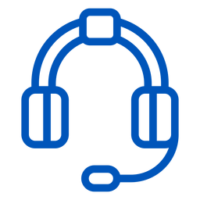Such an important business department as call center just can’t work properly if there is no consistent strategy for measuring its call center performance and makind management decisions based on collected data. As with any other business, call centers have their own call center metrics an call center KPIs (Key Performance Indicators) that are used to measure the performance of a department. These metrics significantly differ for sales call centers and customer service contact center, but the main idea remains the same – you collect data, analyze it, and make decisions focused on performance improvement.
So, what are the key call center metrics you can use to measure call center performance? What are the best practices for call center performance management and improvement? What tools and techniques you can use to improve performance of your call center?
Let’s find it out together.
Key performance indicators of call center performance
The average duration of the conversation, or Average Call Duration (ACD). First of all, don’t confuse it with ACD (Automatic Call Distribution). Secondly, let’s learn why is this metric important. Call center agents often spend nearly the same amount of time on servicing similar customer service calls, and understanding what is the average call duration can help you to understand how many calls can one agent handle per one work shift. On the other hand, when you see significant changes in average call duration, you can make informed conclusions about call center performance – decrease of call duration may point to both positive and negative conclusions: it seems that either agents try to get rid of customers faster, or there are less customer queries that are difficult to resolve.
Call abandonment rate. First of all, let’s deal with the definition of call abandonment rate – it is a percentage of calls that are abandoned due to any reason. In most cases, when we are talking about call abandonment rate, we are talking about calls abandoned by callers themselves due to long wait times. Nonetheless, so-called “lost calls” due to technical reasons can be also included in the term “abandoned calls”. Call abandonment affects call center, as it means you are losing customers, and your company’s reputation is also harmed. Increase in call abandonment rate or even its stable presence on high levels, such as 10-15% and higher means that you have too few agents to handle current call volumes during peak hours. Another factor that can influence call abandonment rate is technical issues, such as connectivity issues and other problems from the side of VoIP provider.
Agent occupancy. Agent occupancy is perhaps one of the most significant call center metris as it shows how much time agents spend on call-related activities, such as handling customer calls themselves, doing after-call work (this work is measured with such a metric as Wrap-Up Time), transferring calls and so on. For measuring all time agents spend on all work activities, including those that don’t relate to calls (training sessions, etc.), you have to use agent utilization rate- another call center metrics that has nothing to do with agent occupancy rate.
Agent occupancy rate is universal metric that can be used by both outbound and inbound call centers to measure agent performance and productivity, as well as schedule adherence (indirectly, of course). There is also a generally accepted call center agent occupancy rate benchmark – 80%, which means that everything that is below this mark means poor performance and requires change management.
Service level. Service level in a call center isn’t a call center metric as we are familiar with it, because it consists of correlation between two rates – average response time (ART, or Average Speed of Answer) and number of calls answered. Service level refers to the standard for service speed and quality agents have to meet, and in most cases, service level uses generally accepted benchmark – 80/20, which means 80% of incoming calls (inbound calls) have to answered within 20 seconds since the call has started.
Average Wait Time. This call center metric works simply – it measures how much time customers wait in call queues before they are connected to the call center agent. From your perspective, the lower is Average Waiting Time, the better it is for customer satisfaction score, customer experience, customer loyalty and customer retention – two key metrics you have to manage. If average wait time starts to grow, it also points to lack of agents or poor call routing settings, so call center managers have to make needed actions.
Average Resolution Time. Average Resolution Time should not be confused with Average handling time – another metric that relates to customer issues resolution, but in the case of Average Resolution Time, we measure how much time it takes to resolve the issue completely from the moment it was delivered to you by the customer, while in the case of Average Handle Time, we mean only the time that is spend by agent to complete all required actions – so if the issue requires any steps from other specialists, including IT or technical professionals, the time they spend on it isn’t included in the Average Handling Time.
There are also many other contact center performance metrics to track in call center industry – First Contact Resolution rates, agent attrition rate, customer satisfaction levels, percentage of calls blocked, transfer rate, customer experience metrics, agent turnover, individual agents metrics, customer effort score, and so on – most of these agent performance metrics have industry standards and can be easily measured by customer service managers. Some metrics require direct customer feedback collected through customer surveys to be measured, such as some agent productivity metrics and customer experience contact center metrics.

